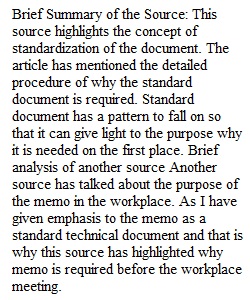


Q When you are writing technical documents, you’ll often be required to summarize and analyze source information. Essentially, summarizing is just what it sounds like: a high-level, brief explanation of what the source includes. Analysis goes one step further in that it allows you to break down the information from the source into its component parts and describe each part individually. A term that may be new to you in this module is synthesis, which is the process of bringing together multiple sources to create something new. In other words, you’re taking various disparate pieces of information, bringing them together, and creating an explanation of how or why they are related. Before completing this activity, be sure to review your readings and videos for this module as well as the module notes. You can find the resources and module notes by clicking the links below: • Module 3 Learning Materials • Module Notes: Research Methods • Module Notes: Researching and Organizing Information Let's Talk The goal of this discussion is to help you practice summarizing, analyzing, and synthesizing information. Part 1: Gather Information In the icebreaker activity this week, you worked together as a class to evaluate potential sources of information for use in this week’s assignment, the technical brief. Begin this discussion activity by going back to the icebreaker and choosing three sources you will use in support of your technical brief. You may use the source you originally contributed to the icebreaker plus two others, or you could choose three new sources that classmates contributed. Choose the sources that make the most sense for your approach to the technical brief. Part 2: Read Your Sources Closely Take the time to read all three sources very carefully. You may find it helpful to take notes or otherwise annotate your sources as you read. As you are reading, consider how the sources are similar and different. Your goal is to summarize one, analyze one, and synthesize all three. Part 3: Craft Your Initial Response When you are ready to make your initial posting, click the “Reply” button. Your initial response should address, at minimum, the following main points: • Write a brief summary of one source. Your summary should not exceed 50 words. Your focus here is on explaining the author’s main ideas very concisely and without judgment. • Write a brief analysis of one source. It should be different from the source you chose to summarize. Your goal in analyzing the source is to break down the parts of the article and discuss how they work together to convey the author’s main idea. Your analysis should not exceed 150 words. • Use all three sources to write a brief synthesis paragraph. Your synthesis paragraph should not exceed 150 words. You are not expected to be an expert on synthesis yet; remember, this is a difficult concept! But, practicing and getting feedback from your instructor and your peers will help you craft a synthesis that should be usable in your technical brief this week. Your initial post is due Thursday by 11:59 pm ET. This week’s initial response must be written, rather than audiovisual. In total, your initial response should not exceed 350 words. Step 4: Connect with Your Classmates and Instructor Respond to the initial posts of at least three classmates and/or your instructor. • When responding to your peers, make connections between your classmates’ experiences and your own. Consider whether you agree or disagree with your classmates’ responses and offer additional information to help develop your classmates’ ideas. • When responding to your instructor, answer any questions that have been posed and offer new, deeper, or broader insight to contribute to the discussion. Peer/instructor interaction posts are due Sunday by 11:59 pm ET. Your peer and/or instructor responses may be posted in written or audiovisual format, and they should not exceed five to seven sentences (or about 100-150 words each). Evaluation The TECH200 Discussion Rubric explains how you will be graded. The discussions combined are worth 20% of your final grade. Outcomes This activity assesses the following module outcomes: • M3-03: Summarize supporting material from various sources. (CO2, CO3, CO4, CO9, CO10) • M3-04: Effectively integrate evidence in specific technical communication contexts. (CO2, CO3, CO4, CO9, CO10)
View Related Questions